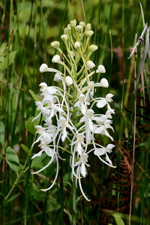White fringed orchid. (Platanthera blephariglottis v. conspicua)
Part of the Florida's Native and Naturalized Orchids Website
Classification:Kingdom: Plantae - Plants
Subkingdom: Tracheobionta - Vascular Plants
Superdivision: Spermatophyta - Seed plants
Division: Magnoliophyta - Flowering plants
Class: Liliopsida - Monocotyledons
Subclass: Liliidae - Lily/related subclass
Order: Orchidales - Orchid order
Family: Orchidaceae - Orchid Family
Subfamily: Orchidiodeae -
Tribe: Orchideae - Orchidoids.
Subtribe: Orchidinae - Orchis and related.
|
Distribution Map: |
Description: Synonyms: Habenaria conspicua Nash, Bull. Torrey Bot. Club 23: 100 (1896); Blephariglottis conspicua (Nash) Small, Fl. S.E. U.S.: 313 (1903); Habenaria blephariglottis var. conspicua (Nash) Ames, Rhodora 10: 70 (1908); Blephariglottis alba var. conspicua (Nash) W.J.Schrenk, Orchidee (Hamburg) 28: 69 (1977); Platanthera conspicua (Nash) P.M.Br., N. Amer. Native Orchid J. 8: 3 (2002) Summary: Terrestrial consisting of a number of triangular, blue-green leaves ascending up a fluted stem, reduced to floral bracts beneath the flowers. Large, 1 inch (2.5 cm), heavily fringed flowers ranging from white to light cream in color. Common Name: White fringed orchid. Habitat: Moist, open pinelands, wet prairies, wet roadsides and ditches. Flowering season: July through September (peaking in August) |
Images:
Description:
One of the showiest orchids found within the state, this species bears heads of flowers than can be six inches (15 cm) tall on plants that can reach three feet (0.91 meters) in height. The White Fringed Orchid blooms at roughly the same time as its cousin, P. ciliaris, which it even resembles in form. In fact, it was at one time considered an albino form of its orange cousin. The flowers, however, are unmistakable with their cream-white color, less prominent fringe and proportionally larger column.
In recent years, this orchid has become more difficult to find, even in areas where it has been known traditionally to grow. The particular area where we photographed these plants used to be known for having a sizable population of plants. Now, only 30 or 40 plants remain in one small wooded area. In regions where its cousins, P. cristata and P. ciliaris are found nearby, the natural intergrades/hybrids P. x canbyi and P. x bicolor are often found, respectively.
The taxonomy on this variety can be a little confusing. Paul Martin Brown (N. Amer. Native Orchid J. 8: 3 (2002)) elevates this to the level of a separate species, P. conspicua, and this seemed to be the accepted taxon for awhile. Now, the trend seems to be reversing with the Kew Monocot Checklist and Wunderlin's Atlas of Florida Vascular Plants from USF listing this as a variety of P. blephariglottis (as it was when Luer wrote his epic work The Native Orchids of Florida). This website is adopting this same nomenclature for the time being.
Copyright © 2009-2020 Prem Subrahmanyam, All Rights Reserved.
No Text or Images from this web site may be used, in whole or in part, without the express permission of the author.
For further information, see the Terms of Use page.














